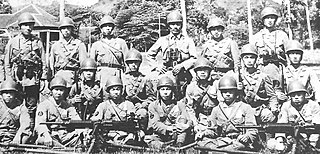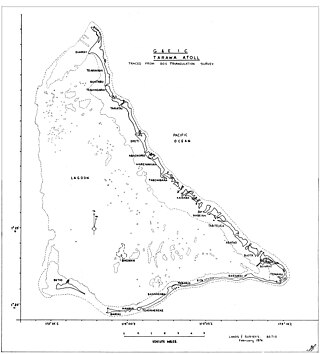
The Southern Expeditionary Army Group was a general army of the Imperial Japanese Army during World War II. It was responsible for all military operations in South East Asian and South West Pacific campaigns of World War II. Its military symbol was NA.

The Special Naval Landing Forces were naval infantry units of the Imperial Japanese Navy (IJN) and were a part of the IJN Land Forces. They saw extensive service in the Second Sino-Japanese War and the Pacific theatre of World War II.

Keiji Shibazaki was a Rear Admiral in the Imperial Japanese Navy. He was the commander of the Japanese garrison on the island of Betio of the Tarawa atoll during World War II.

The Special Type 2 Launch Ka-Mi was the first amphibious tank of the Imperial Japanese Navy (IJN). The Type 2 Ka-Mi was based on the Imperial Japanese Army's Type 95 Ha-Go light tank with major modifications. It first saw combat service during the Guadalcanal campaign in late 1942.

This is a list of Imperial Japanese Navy armored units that were equipped with Type 89 Chi-Ro medium tank, Type 95 Ha-Go light tank, Type 97 Chi-Ha medium tank and the Type 2 Ka-Mi amphibious tank.

The Japanese marine paratroopers was a marine airborne forces during World War II. The troops were officially part of the Special Naval Landing Forces. They came from the 1st, 2nd and 3rd Yokosuka SNLFs. The 2nd Yokosuka took no part in any airborne operations and became an island defensive base unit. They were under the operational control of the Imperial Japanese Navy Air Service. Rikusentai paratroopers should not be confused with the Imperial Japanese Army paratroopers, known as Teishin.

Yaeyama (八重山) was a small minelayer of the Imperial Japanese Navy, which was in service during the Second Sino-Japanese War and World War II primarily as an escort vessel. She was named after the Yaeyama Islands in the Ryukyu Islands chain. She was the first Japanese warship built with an all-welded hull.

The Japanese destroyer Mutsuki was the name ship of her class of twelve destroyers built for the Imperial Japanese Navy (IJN) during the 1920s. During the Pacific War, she participated in the Battle of Wake Island in December 1941 and the occupations of New Guinea and the Solomon Islands in early 1942. Mutsuki was one of the escorts for the invasion force during the Battle of the Coral Sea in May and then participated in the Guadalcanal Campaign later that year. The ship was sunk by American bombers during the Battle of the Eastern Solomons in August.
Below is the order of battle for the Amoy Operation fought May 10–12, 1938, part of a campaign by the Imperial Japanese Navy to blockade the Republic of China during the Second Sino-Japanese War.

USS LST-1074 was an LST-542-class tank landing ship built for the United States Navy during World War II. She was later named Overton County (LST-1074) for the Overton County, Tennessee—the only U.S. Naval vessel to bear the name—but never saw active service under that name.
The 2nd Maizuru SNLF was an infantry battalion of the Imperial Japanese Navy's Special Naval Landing Forces.
The 3rd Kure Special Naval Landing Force were two infantry battalions of the Imperial Japanese Navy's Special Naval Landing Forces.
The 5th Kure Special Naval Landing Force was a naval infantry battalion of the Imperial Japanese Navy's Special Naval Landing Forces.
The 5th Yokosuka Special Naval Landing Force was an infantry battalion of the Imperial Japanese Navy's Special Naval Landing Forces.

The Sumida M.2593 was an armoured car produced by the Empire of Japan in the 1930s. It could operate on both the roadway and railway lines. There were two main versions of the Sumida M.2593 made. The Type 91 armoured railroad car was used by the army and the Sumida Model P armored car was used by the Special Naval Landing Forces (SNLF) of the navy.
Masajiro Hayashi was an officer in the Imperial Japanese Navy during World War II. He was a member of the 51st Class of the Imperial Japanese Naval Academy, ranking 182 out of 255 Cadets. He was in command of forces during the Battle of Milne Bay until he was apparently killed during the battle. Other sources state that he was relieved of command by Minoru Yano.
Yamafuku Maru was an auxiliary transport ship of the Imperial Japanese Navy during World War II. She served primarily as a troop transport and cargo ship during the war.
I-43 was an Imperial Japanese Navy Type B2 submarine. Completed and commissioned in 1943, she served in World War II and was sunk during her first deployment in February 1944.
Sanuki Maru (Japanese:讃岐丸) was a 1939-built cargo ship, requisitioned as a seaplane tender by the Imperial Japanese Navy during World War II.

On 10 November, 1943, men of the United States Marine Corps invaded the island of Betio, located at the southwest corner of Tarawa Atoll in the Gilbert Islands chain in the Central Pacific. This invasion, known as Operation Galvanic, was a phase of the Pacific Theatre of World War II.











